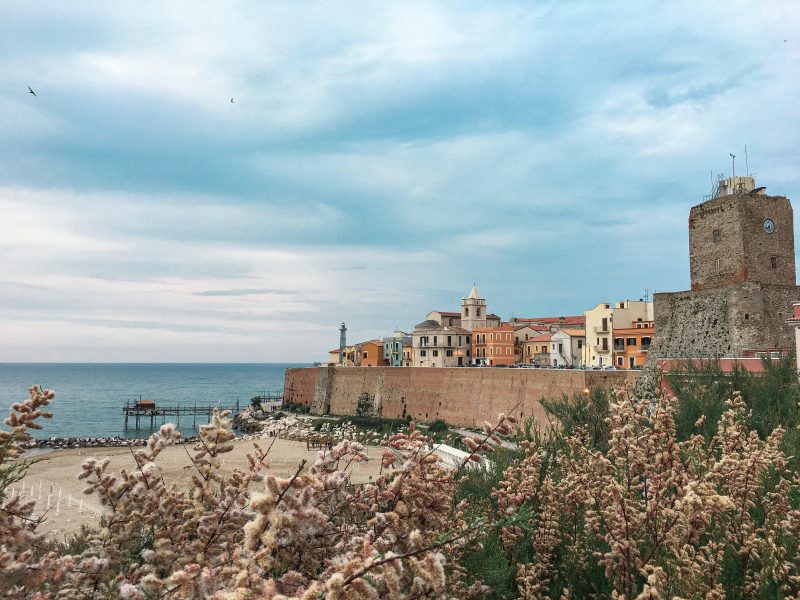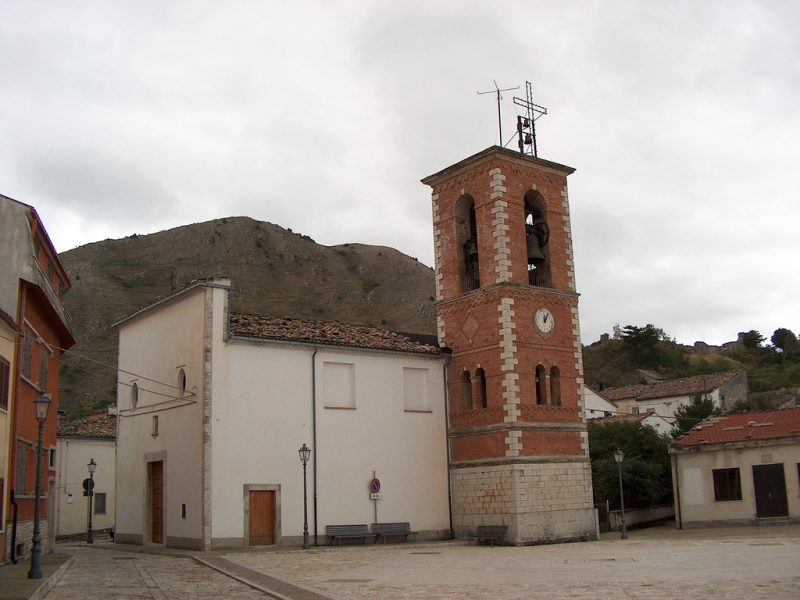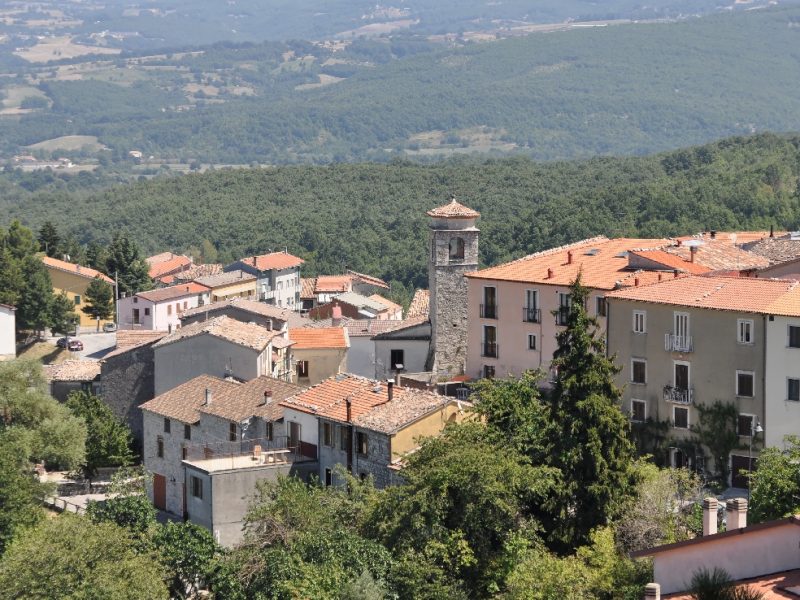The Borgo of Larino
The borgo of Larino lives in perfect symbiosis with the abundant nature around it, as if one could not exist without the other. The sloping roofs of the houses are immersed in the delicate green of the olive trees and the percuozz, the ancient oak forests and aromatic herbs intertwining with the forest trails.
Larino, reclining elegantly in the rolling hills, recounts stories of its glorious battles and the terrible Christian persecutions carried out in its amphitheatre. The ancient streets and buildings are narrators of a past in which the Vallone della Terra marks an imaginary line between the ancient Roman municipality of Larinum, the Medieval city of Larino and the historical center of the city today.
The life of this borgo in Molise scrupulously follows the calendar year: every month brings its ancient traditions and customs to be respected, along with the typical dishes to consume that month, rigorously accompanied by the local wine! A continuous cycle, waiting in anticipation for May, the month when Larino is reborn, thanks to the bounty of nature that explodes in full glory, overwhelming everything with the splendor of fresh new life. The balconies and surrounding woods burst into bloom with the infinite colors and scents of flowers; the fields are dressed in brilliant green, and the bells chime gaily in celebration of the month of the patron saint, San Pardo. During the festival, the city shines bright with festive lights, time and space stop their incessant race, and the streets fill with processions and the myriad vivid colors of the traditional ox-driven carts. It is a time of joy and laughter, a time to honor the patron saint and finally celebrate the rebirth of Larino after the long winter.
Larino stands on the San Leonardo plain, an area rich in history, spanning all the way back to human settlements in prehistoric times. The foundation of Larino is extremely ancient, dating back to five hundred years before the founding of Rome. It was founded as “Frenter” by the Frentani, a population of Samnite origin. This original settlement was destroyed and later re-founded with the name “Ladinod”, modified several times over the centuries, to eventually become “Larino” in the 1800’s.
In Roman times, “Larinum”, was a city of great importance, evidence of which can be found in the numerous thermal spas scattered throughout the town and above all, the large and imposing amphitheater. During the reign of the Roman Empire, even the lawyer Marco Tullio Cicerone came to Larino. One of the most important authors of Latin literature, in 66 BC, Cicerone gave the famous oration, Pro Aulo Cluentio Habito, in the forum of Larino, in defense of Aulo Cluentio, a Roman patrician accused of homicide.
During the second Punic War between Rome and Carthage, which raged between the years of 219 and 201 BC, Hannibal and his army clashed with the dictator of Larino, Fabio Massimo.
The advent of the Lombards in Italy led to a reduction of the importance of the city, which was reabsorbed into the territory of Benevento, becoming the capital of one of the thirty-four counties in which the territory was divided.
An important influence in Larino’s history was the propulsive drive created presence of an ancient diocese, established at the end of the fifth century. In 824, the relocation of the relics of San Pardo marked the beginning of the exodus from the city on the hill to the one built on the plain, equipped with defensive walls to protect the inhabitants from the continuous raids by the Hungarians and the Saracen Turks. In 1319, the Cathedral of Larino was built, and in 1564 the Bishop Balduino commissioned the construction of the first Seminary of the Catholic religion.
During the Middle Ages, Larino’s importance grew, so much so that the outlying territory was called the “Larinate”. The borgo developed around the palace of the Carafa family, feudal lords who are linked to a story known as “The Larinese Conspiracy”, which is recounted by Alexander Dumas in his novel “A Bloody Kingdom”. The author of “ The Count of Montecristo” and “The Three Musketeers”, was not privy to the events in Larino by chance: he adored spending long periods of time in the borgo, which was one of his favorite destinations whenever he visited Italy.
In 1806, with the reorganization of the Kingdom of Naples, Larino passed into the new district of Molise and began to enjoy a state of autonomy.
In 2000, the President of the Republic, Carlo Azelio Ciampi conferred the title of “Città” to Larino.
Between October 31 and November 2 of 2002 a series of terrible earthquakes devastated the region of Molise, and Larino was one of the cities worst hit. Many historic buildings were seriously damaged, and the Palazzo Ducale was not reinstated as the Town Hall until restoration was completed in 2009. Many schools and churches remain under reconstruction and still remain closed today.
The Cathedral
The Diocese of Larino-Termali is relatively recent, established only thirty years ago. However, Larino itself has been a Diocese since the fifth century AD, and the Catholic Church has played an important role in the development of the city, especially concerning religious buildings. The most important symbol of the Christian faith in Larino is the Cathedral, dedicated to the Assumption and San Pardo.
Construction of the Cathedral terminated in 1319, when the façade commissioned by Pope Giovanni XXII was completed. Nevertheless, the cathedral has undergone numerous remodeling interventions that have modified its original features. The façade, for example, was created with an especially delicate type of stone requiring continual restoration interventions.
The façade of the cathedral is enclosed in a perfect square, the symbol of Christ. It is characterized by a portal in Romanesque Apulian style, with a series of columns that narrow around the lunette, in which you can see a bas-relief of the crucifixion with an angel appearing from above to help Jesus.
The central area is surmounted by a rose window in Gothic style with thirteen rays symbolizing Jesus and his disciples, with the four evangelists and the Lamb of Christ distributed around them. The lamb is the only symbol repeated twice in the façade, appearing again in the central tympanum.
The lamb is a recurring symbol in Christianity and Judaism, representing the sacrifice of Christ, and more generally, the sacrifice of humanity.
At the beginning of the 1700’s, the Romanic and Gothic styles in the interior were supplanted by decorations in Baroque style, which were later partially eliminated. Of the altars that line the perimeter, of particular impact is the altar with a bishop’s throne, created by the Neapolitan artist Lorenzo Troccoli, one of the greatest marble sculptors of his time. The bishop commissioned all the altars in Larino and the surrounding towns by this same artist.
Palazzo Ducale e Museo Civico, The Ducal Palace and the Civic Museum
The Ducal Palace of Larino was built between 1100 and 1200 by Norman counts during the Lombard domination. Today, the palace is in the center of the town, but in antiquity it was probably
near the axis of the main road. Over the years it has undergone extensive remodeling, transforming from a simple structure to a fortress of enormous dimensions, to its final reincarnation as an elegant noble home, thanks to the last feudal rulers in Larino, the De Sangro family. In the 1800’s the Palazzo Ducale was purchased by the municipality, and further modifications were implemented, including the entrance on to Piazza Vittorio Emanuele.
After an earthquake that struck Molise in 2002, the palace was in need of extensive restoration, and was finally reopened in 2009. Today, it is the site of the City Hall, and in the mayor’s office, you can admire a magnificent fresco from 1907 by Luigi Benevento depicting a wing, the symbol of Larino.
The third floor of the building hosts the City Library and the Civic Museum. When the first ruins of the Roman amphitheater were uncovered, a place was needed to house the most important historical relics, and so this museum was founded. As was customary in the post-war period, the elaborate mosaics were removed and transported to the new museum, where they are still on exhibit. The museum also exhibits examples of the daily life of the inhabitants, as well as evidence of the importance of this city in past eras, as demonstrated by the coins produced in the mint of Larino, which reached the height of its importance between the third and second centuries BC.
Amphitheatre
The amphitheatre of Larino is the most evident example of the city’s importance during the Roman Empire. It was constructed during the reign of the Emperor Flavio, thanks to funding by a senator from Larinum. Studies indicate that the amphitheatre could hold around eleven thousand spectators, and that it was partly excavated in tuff stone, and partially constructed above ground. The amphitheatre was full of decorations and mosaics, of which today remain only the podium and parts of diverse architectural elements.
During excavations, it came to light that to build a construction of such vast dimensions, some of the buildings nearby had to have been demolished. In fact, the ruins of a necropolis from the eighth century BC was discovered, as well as road dating back to the sixth century BC.
The amphitheatre was used for a long span of time, and even while it was in use, restoration interventions were necessary.
The Roman amphitheater fell into disuse during the late Roman Empire, and during the Middle Ages it was used as a burial area.
Larinum
It was customary for the Romans to build thermal baths near large public places, and in fact, near the Roman amphitheatre of Larino there are thermal baths dating back to the second century AD.
They are not the only public baths in Larino, but the baths near the amphitheatre stand out because of their spectacular mosaics depicting real and imaginary marine life, and for the magnificent flooring similar to that of Rome or Pompeii. In the centuries that followed, the ruins of Larinum were incorporated into new civil constructions, in fact, a villa built over the baths of the amphitheatre still conserves the original Roman flooring. Today it is the site of a museum.
In the area around Larin’s nursery school, excavations have brought to light the ruins of a paved road, with workshops on one side and on the other, civil dwellings with finely crafted mosaic floors, the most noted being the mosaic of Kontheros, a timeless masterpiece that has remained almost perfectly intact.
Larino also had an important forum that was reduced in size in the first century AD, to make room for a series of imposing buildings. This explains why, in the area of Sant’Anna, an entire area of artisanal workshops and public buildings probably connected to the activities of the forum were discovered. Near this area, a domus from the Roman Republican era was found, built around a central atrium, featuring flooring created with multi-colored stones. In the area of the forum, a square-shaped building was found, which could coincide with a temple dedicated to Mars, the god of War, dating back to the first century AD. Another sacred place, dating back to Ancient Greece, was found in the area of via Jovine.
The city of Larinum was surrounded by the necropolis, and in the outlying areas and near the train station, tombs have been found dating back to between the fourth century BC to the second and third century AD.
The Festival of San Pardo
For the citizens of Larino, the celebrations in honor of San Pardo represent a reunification with their history and with a centuries-old tradition. In 842, Larino was invaded and looted by the blood-thirsty Saracen Turks on their rampage through the South of Italy. In Larino, the Turks also stole the relics of the holy martyrs of the borgo, to whom the population felt a deep bond. To bring them back home, the few survivors that were left after the attacks set out in the direction of Lesina, in search of their stolen saints. Along the way, they came across the tomb of San Pardo. The discovery was immediately interpreted as a divine sign, and they decided to bring the saint’s remains back with them, transporting him to Larino in a cart decorated with colorful flowers.
Still today, this event is commemorated on the 24th to the 27th of May, when more than one hundred carts parade through the streets, pulled by real oxen or oxen carved in wood. The preparation of the carts is a tradition that involves the entire family, who follow a prescribed ritual passed down over the centuries. For the entire month of May, the local women prepare paper flowers, ribbons and blankets, which will be put on the carts on the 24th of May. On the 25th, the carts depart ‘en masse’ from the chapel dedicated to the Larinese martyr, San Primiano, carrying the statue of the saint through the historical center all night. On the 26th there is a ceremony at the church of St Pardo, and the oxen are blessed from the water of the Fontana di San Pardo, and then the statue of San Pardo joins the procession. The festival concludes on the 27th of May, when San Primiano is taken back to his church, and after the community celebrates Holy Mass, and a joyful banquet, everyone goes back to the Cathedral of Larino, where the statue of San Pardo is returned home.
The tradition of the “Carri Larinesi” (the ox-carts of Larino), is one of the most ancient and fascinating Christian traditions, attracting visitors from all over Italy.
Il Culto di San Giuseppe, The Worship of St. Joseph
St. Joseph, or San Giuseppe, was a poor man who accepted his son as a gift from the Lord, and who raised him without being ashamed of his origins, or of his humble work as a carpenter. Today, the worship of San Giuseppe is practiced by few people, but in the past he was very important to Larino. The rituals for the festival of San Giuseppe began on the 23rd of January, the day of his marriage, concluding on the 19th of March, the date representing abundance. For the occasion, every family invited three beggars to their table: a youth, a woman, and an elderly man, offering them dishes made with vegetables, legumes and cod, or baccalà.
“The table of San Giuseppe” is a widespread custom in various towns, particularly in Salento. In Larino, nine days before the 19th of March, the tables are decorated with refined lined tablecloths, in honor of the ‘novena’ (the nine day worship), and on March 18th the tables are blessed, with small statues of saints protected in glass domes on every family altar.
The decoration of the tables of San Giuseppe involves all the women in the family, who have been preparing a special bread crumb condiment for the pasta all week. After the altars have been blessed at midnight, the preparation of thirteen traditional dishes begins: using broad beans, chicory, fish, citrus fruits, asparagus, rice, and escargots (snails), everything except meat, as a sign of respect for Lent. During the preparation of the food, nothing is tasted, because the first taste must be made by the woman, the elderly man, and the youth who have been invited. Another custom linked to the worship of San Giuseppe is the pilgrimage to all of the chapels in the town, where visitors are offered “scripelle”, a traditional sweet fried bread.
In Larino, one of the symbolic dishes of this holiday is the maccarruni di San Giuseppe, which consists of ‘bucatini’ pasta with breadcrumbs and another thirteen ingredients. The pasta is traditionally eaten with your hands and has a highly symbolic meaning for the community of Larino.
Alexandre Dumas senior and the Larinese Conspiracy
Alexandre Dumas is a French writer, the author of The Count of Montecristo and The Three Musketeers two of the most important classics in literature.
The French playwright, after hearing about an event that occurred in 1679 that was known as the ‘Larinese Conspiracy’ decided to use it for his novel ‘A Bloody Kingdom’, also known as ‘Luisa Sanfelice’.
Dumas decided to set his novel a century later than the events actually occurred, in 1799, at the height of the Neapolitan Revolution.
The Larinese conspiracy was a plot hatched by the local nobles, supported by the clergy, to eliminate feudal power. Their victim was the feudal lord, Francesco Maria Carafe, who was attacked as he made the steep climb to the Convento dei Cappuccini.
Aldo Biscardi
Aldo Biscardi was born in Larino on November 26, 1930. After receiving his degree in Law at the Università Federico II of Naples, he began his journalistic career in the editorial staff of the national newspaper ‘Il Mattino’.
In 1979, he joined the national public television network the RAI, and in 1980 he launched “Il processo del lunedì” (The Monday Trial) on channel RAI 3, which mainly dealt with in-depth analyses of A Series football matches.
In 1983, after being heavily attacked by mogul/politician Silvio Berlusconi, he abandoned the RAI and went to the station ‘Tele +’, and then to ‘TeleMontecarlo’, which today has become the liberal and prestigious ‘La 7’.
Television host, journalist, and the director of various sport magazines, Aldo Biscardi passed away in Rome on October 8, 2017, at the age of eighty-six.
____________________________________
Do you known of any famous people related to this borgo? Contact us!

 Italiano
Italiano
 Deutsch
Deutsch







